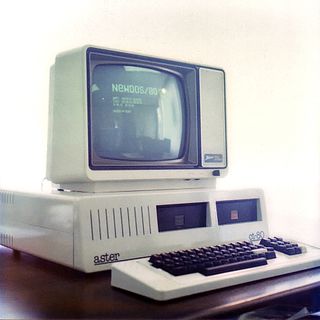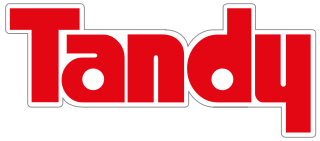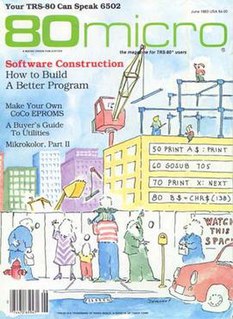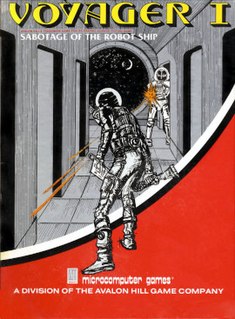
The Aster CT-80, an early (1982) home/personal computer developed by the small Dutch company MCP, was sold in its first incarnation as a kit for hobbyists. Later it was sold ready to use. It consisted of several Eurocard PCB's with DIN 41612 connectors, and a backplane all based on a 19-inch rack configuration. It was the first commercially available Dutch personal/home computer. The Aster computer could use the software written for the popular Tandy TRS-80 computer while fixing many of the problems of that computer, but it could also run CP/M software, with a large amount of free memory Transient Program Area, (TPA) and a full 80×25 display, and it could be used as a Videotext terminal. Although the Aster was a clone of the TRS-80 Model I it was in fact more compatible with the TRS-80 Model III, and ran all the software of these systems including games. It also had a built in speaker which was compatible with such games software.

The TRS-80 Micro Computer System is a desktop microcomputer launched in 1977 and sold by Tandy Corporation through their Radio Shack stores. The name is an abbreviation of Tandy Radio Shack, Z80 [microprocessor]. It is one of the earliest mass-produced and mass-marketed retail home computers.

The RadioShack TRS-80 Color Computer, later marketed as the Tandy Color Computer and sometimes nicknamed the CoCo, is a line of home computers developed and sold by Tandy Corporation. Despite sharing a name with the earlier TRS-80, the Color Computer is a completely different, incompatible system and a radical departure in technology with its Motorola 6809E processor rather than a Zilog Z80.

Tandy Corporation was an American family-owned leather goods company based in Fort Worth, Texas, United States. Tandy Leather was founded in 1919 as a leather supply store. By the end of the 1950s, under the tutelage of then-CEO Charles Tandy, the company expanded into the hobby market, making leather mocassins and coin purses, making huge sales among Scouts, leading to a fast growth in sales.
The Tandy 2000 is a personal computer introduced by Radio Shack in September 1983 based on the 8 MHz Intel 80186 microprocessor running MS-DOS. By comparison, the IBM PC XT used the older 4.77 MHz Intel 8088 processor, and the IBM PC AT would later use the newer 6 MHz Intel 80286. Due to the 16-bit-wide data bus and more efficient instruction decoding of the 80186, the Tandy 2000 ran significantly faster than other PC compatibles, and slightly faster than the PC AT. The Tandy 2000 was the company's first computer built around an Intel x86 series microprocessor; previous models used the Zilog Z80 and Motorola 6809 CPUs.

The TRS-80 MC-10 microcomputer is a lesser-known member of the TRS-80 line of home computers, produced by Tandy Corporation in the early 1980s and sold through their RadioShack chain of electronics stores. It was a low-cost alternative to Tandy's own TRS-80 Color Computer to compete with entry-level machines such as the Commodore VIC-20 and Sinclair ZX81.

The EACA EG2000 Colour Genie was a computer produced by Hong Kong-based manufacturer EACA and introduced in Germany in August 1982. It followed their earlier Video Genie I and II computers and was released around the same time as the business-oriented Video Genie. The BASIC was compatible with the Video Genie I and II and the TRS-80, except for graphic and sound commands; most of the routines for Video Genie I BASIC commands were left over in the Colour Genie's BASIC ROM. Programs were provided to load TRS-80 programs into the Colour Genie. Colour Genie disks could be read in a TRS-80 floppy disk drive and vice versa, editing the pdrive commands.

Dungeons of Daggorath is one of the first real-time, first-person perspective role-playing video games. It was produced by DynaMicro for the TRS-80 Color Computer in 1982. A sequel, Castle of Tharoggad, was released in 1988.

Scripsit is a word processing application written for the Radio Shack TRS-80 line of computers. Versions were available for most if not all computers sold under the TRS-80 name, including the Color Computer and several pocket computer designs, as well as the Tandy version of the Xenix operating system. Tandy Corp. also produced a version running under MS-DOS for its line of PC compatible computers. Some of the 8-bit versions are tape-based and have no ability to read or write to disk.

80 Micro was a computer magazine, published between 1980 and 1988, that featured program listings, products and reviews for the TRS-80.
Spectral Associates was an American maker of computer games for the TRS-80 Color Computer. It was founded in 1980 and was defunct as sometime in the late 1980s. Spectral Associates sold their software through Radio Shack and via direct sales. It was a very prolific game company for the TRS-80 Color Computer I and II in its heyday.
Draconian is a multidirectional shooter released in 1984. It was written by Mike Hughey and published via Tom Mix Software. The game was initially released for TRS-80 Color Computer and converted for the Dragon 32/64. Draconian is based upon the arcade game Bosconian where the player navigates a ship through scrolling space to destroy enemy bases.
TRS-80 is the name of Tandy Corporation's original 1977 microcomputer system. The TRS-80 brand was also later applied to many different computers sold by Tandy, including several unrelated in design to the Model I.
Extended Color Basic is an update to the Color BASIC interpreter for the Radio Shack/Tandy TRS-80 Color Computer series and is the default Basic interpreter, for the Color Computer 2. The Color Computer Basic implementations are somewhat different for the versions of Basic which come with the other family of TRS-80 machines, namely Basic Levels I, II, and III. Assemblers and Pascal and C compilers are available for the different machines in the series. Modified subsets of Color Basic may be found on many of the Radio Shack PC series of pocket computers of the era.

Voyager I: Sabotage of the Robot Ship is a computer game designed and programmed by William D. Volk, and published by the Microcomputer Games division of Avalon Hill. It was originally released for the Apple II in 1981, with later versions for the Atari 8-bit family, TRS-80 Color Computer, TRS-80, and Commodore PET.
Demon Seed is a fixed shooter written by Jeffrey Sorensen and Philip MacKenzie for the TRS-80 and published in 1982 by Trend Software. The same programmers developed the TRS-80 Color Computer version published in 1983 by Computer Shack. Demon Seed is a clone of the 1980 arcade game Phoenix.

The Sands of Egypt is a 1982 graphic adventure game written by James Garon, Ralph Burris, and Steve Bjork of Datasoft for the TRS-80 Color Computer. It was licensed to Tandy Corporation and was the first disk-only game for the Color Computer sold by RadioShack. Ports to the Atari 8-bit family in 1982 and Apple II in 1983 were published by Datasoft. Set in 1893, the game follows a British explorer and archaeologist who is lost in the desert. Text commands are entered in the lower half of the screen, while a sometimes animated image of the current location is displayed in the upper half.












